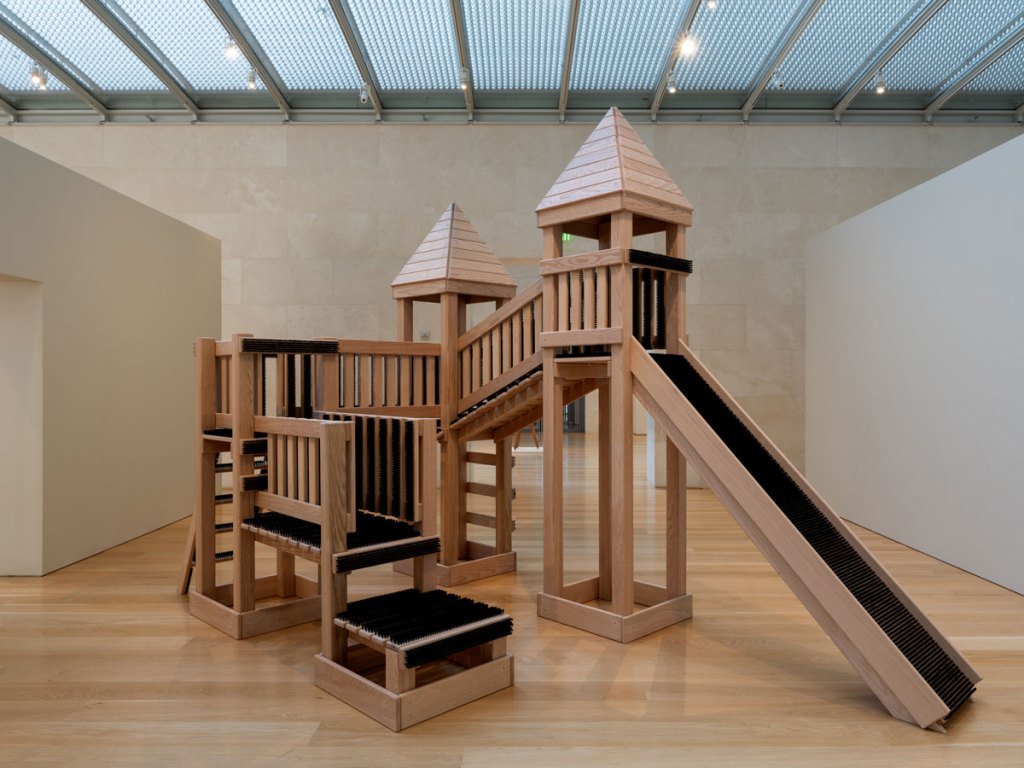In the late 1980s, in a suburb of Dallas, an estimated 5,000 community members took part in creating Kidsville, an all-wood, medieval-inspired extravagant playground that claimed to be the largest volunteer-built playground in the world, aided by children raising funds through penny drives and local retailers supplying equipment and wood.
Speaking to a community’s resourcefulness, the story of Kidsville, completed during two weeks in April 1989, serves as a fitting introduction to Hugh Hayden’s nostalgic-laden solo exhibition, “Homecoming,” at the Nasher Sculpture Center in Dallas, the city where the artist grew up. Hayden’s life-size reconstruction of Kidsville, Brush (all works 2024), features its play areas—staircases, clatter bridge, slide—covered in boar hair bristles, rendering this treasured structure unusable and unexpectedly scratchy. But the work also flirts with sentimentality: boar bristle brushes are known for their natural power to detangle and leave your hair with a shiny finish, an apt metaphor for nostalgia’s power to render formative experiences into a silky-smooth haze.
Defined by Hayden’s return to Texas, the works in “Homecoming” are laced with a kernel of vulnerability that hides beneath their elusive, lustrous surfaces, ruminating on the challenges of growing up Black and queer in the American South. Take Blending In, in which a football uniform covered in bark hangs from a suite of lockers. In a section looking at high school awkwardness and anxieties in common areas, the heartfelt work embodies hiding one’s queerness for fear of social rejection within the protected status of Big Man on Campus. Similarly, the installation Cutting Board features an industrial lunchroom table, its wood surface crawling with a forest of red graphite tipped appendages, sandwiched between two mirror walls akin to a dance studio. The sparse installation plays into the juxtaposition of multiple high school stressors: the cafeteria and the locker room. Your every move, including where you decide to sit, is being observed, refracted infinitely through the mirrors.

Hugh Hayden, Cutting Board, 2024, installation view, at Nasher Sculpture Center, Dallas.
Photo Kevin Todora/©Hugh Hayden/Courtesy Lisson Gallery
Elsewhere, Hayden divides the exhibition space via false walls and passageways, suggesting domestic spaces where skeletons and refashioned housewares hint at the ghosts that haunt us. Get Together, a collection of skillets and stock pots with African masks cast into and protruding from their polished surfaces, recalls slavery’s direct ties to postbellum domestic labor, while Laure, a modern take on Manet’s Olympia (1863) shows a skeleton of the model’s Black servant, Laure, on a white couch, where she is given a chance to rest. The specters of history are even more pronounced in Made in Heaven, of two intertwined white oak skeletons with found tools—a broom, mop, shovel, or spade—for feet are confined to a closet. In using skeletons, Hayden makes the reading of these figures intentionally ambiguous: they could be same sex, mixed race, or any number of combinations.

Hugh Hayden, Laure, 2024, installation view, at Nasher Sculpture Center, Dallas.
Photo Kevin Todora/©Hugh Hayden/Courtesy Lisson Gallery
Other works in the exhibition recall earlier pieces by Hayden but with a twist befitting his return to home. Pecanocchio, a new iteration of Hayden’s childhood puppet sculptures, is fashioned from a photograph of Hayden as a toddler, matching his innocent gaze and cherry red romper, while Force Field (2024) arranges three of Hayden’s medications—blue HIV prevention pills, white allergy capsules, and red hair-loss-prevention tablets—into the shape of a flag, this time a fluttering Lone Star ensign for a deadpan take on pride.
Hayden’s candor, however, can feel fleeting as his work is firmly planted in the middle of meanings, where two opposing perspectives often simultaneously exist. It’s up to viewers to ultimately decide what they take from the exhibition. Supper,a dining room table covered in sprouting eraser-topped twigs, for example, can be about the frustrating ubiquitousness of the nuclear family in suburban America or, for those who find that element of Americana outside their grasp, it captures the longing for a more normative experience. The pint-sized church of Happily Ever After can be about the pervasiveness of religion in the South or it can reflect a full-throated embrace of the institution’s transformative nature and its powerful effect on a young person trying to comprehend the world.

Hugh Hayden, Blending In, 2024, installation view, at Nasher Sculpture Center, Dallas.
Photo Kevin Todora/©Hugh Hayden/Courtesy Lisson Gallery
Those already enchanted by Hayden’s surrealist suburbia will find a tender presentation that shows the artist reflecting on personal history as a way to open up to something bigger, while those new to his work will likely glean the reason behind his rising popularity in a survey that captures of the breadth of his potent aesthetics. “Homecoming” (on view through January 5) speaks to the self-reflexive power and unique motivations that coincide with returning to one’s old stomping grounds—and the honest, surprising revelations that the voyage can inspire.







